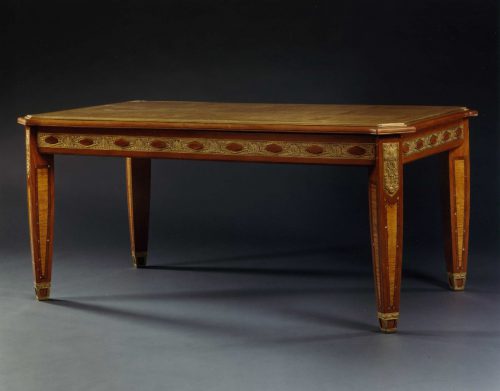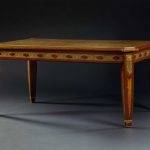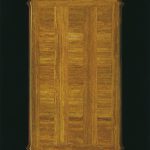9210 A GILT-BRASS MOUNTED AND INLAID CENTER TABLE WITH UNUSUAL PARQUET PATTERN GOLD TRAVERTINE TOP BY LOUIS MAJORELLE Nancy. Circa 1908. Measurements: Height: 30″ (76.5cm) Width: 67 3/4″ (172cm) Depth: 41″ (104cm)

Research
Of purplewood, boxwood, mother-of-pearl, and gilt-bronze. The rectangular top with canted corners inset with a parquet of gold travertine with a gilt-bronze molded edge, the frieze mounted to each side with a gilt-bronze panel with stylized foliate decoration pierced with shaped lozenges, the whole raised on four tapering lozenge-shaped legs, each headed by a stylized foliate gilt-bronze panel, each leg inlaid to three sides with a shaped satinwood panel with cross-banded border inset with mother-of-pearl, each leg terminating in a pierced gilt-bronze mounted foot.
Marks:
One leg inlaid to the inside with circular disk
‘MAJORELLE NANCY’
Provenance:
Private Collection, Barcelona
Published:
Louis Majorelle: Master of Art Nouveau Design by Alistair Duncan, London: Thames & Hudson Ltd., 1991. 167, figure 10.
The inlaid signature MAJORELLE NANCY establishes this fascinating table as the work of the celebrated Art Nouveau and Art Deco furniture maker Louis Majorelle. Its innovative top is composed of gold travertine marble tiles, intended to evoke a wood parquet surface, both through the cut along the vein of the stones and their arrangement.
A contemporary photograph dating from between 1903 and 1908 shows a table of the same model as the present piece within a room setting of Majorelle’s works (figure 1).1 With boldly shaped and canted inlaid legs, striking mounts, especially to the frieze, and a finely polished conforming top, it is almost certainly the present piece. It is pictured in the same room as a side cabinet which shares the same lozenge-shaped mounts to the frieze and appears to be en suite with the table.
The date of the photograph places the table in the period of Majorelle’s most successful and acclaimed production, when the quality of the workmanship was at its height. Yet this period is also still primarily associated with Majorelle’s Art Nouveau idiom, rather than the distinctly progressive rectilinear design of the present table.
This more geometric phase of Majorelle’s work is usually associated with the cabinetmaker’s output after the first World War, when he came under the influence of the Art Deco Movement. The Art Deco aesthetic was just beginning to emerge in France around 1908, and the work of younger cabinetmakers such as André Groult and Louis Süe is usually cited as heralding the post-Art Nouveau avant-garde in French furniture design.
However, the appearance of a table of the present form in a photograph of between 1903 and 1908 places Majorelle in the vanguard of the stylistic developments of the day. Its pared-down geometric form and stylized repeat pattern gilt-bronze mounts suggests a degree of experimentation with more progressive designs in Majorelle’s work at an earlier date than usually acknowledged. The use of geometric inlay to the legs adds to the sense of modernity which the table would have encapsulated in 1908, as does the distinctive and unusual marble top, which is particularly fascinating as it is composed of a geometric system resembling a parquet as found in floors.
The use of travertine is prescient as its deployment was only to become fashionable later in the 20th century in high-quality architecture as cladding material for the lobbies of Modernist buildings. Henry Moore was famously to champion the material, using it for sculptures in the 1950s and 60s and in a table he designed for his own home. It is possible that Majorelle was using the material as an evocation of the Ancient, as travertine was much favored as a building material in ancient Rome. The essentially neoclassical form of the piece would further lend validity to this theory, and as such the present table can be afforded an important place in the stylistic chronology of Majorelle’s career.
Louis Majorelle was perhaps the most renowned French furniture maker of the turn of the century. At the height of his powers, between 1898 and 1908, Majorelle created pieces of a breathtaking quality, which were thought by contemporaries to rival the best traditions of 18th-century French furniture. Majorelle’s pieces were characterized by an endless selection of luxurious woods set with lavish mounts of gilt-bronze and brass and metal inlays. Such was the standard of Majorelle’s productions, his biographer Alastair Duncan asserted, that “nothing comparable had appeared in French furniture for a hundred years.”2
Majorelle was born near Nancy in 1859, the son of a cabinetmaker and potter. Having trained as a painter and studied under Jean-Francois Millet at the École des Beaux-Arts in Paris in the late 1870s, Majorelle returned to Nancy to run the family business after his father’s death, continuing to make furniture in the styles of Louis XV and Louis XVI.
Around 1894 Majorelle came under the influence of the Nancy glass- and cabinetmaker Emile Gallé and began to develop a more adventurous Art Nouveau style. By 1897 Majorelle had abandoned the revival styles altogether and was beginning to produce the works that led to his acknowledgement as the undisputed master of Art Nouveau furniture. Majorelle’s reputation as the preeminent French cabinetmaker of the time was firmly established three years later at the Exposition Universelle of 1900 in Paris, where he was awarded the Chevalier de la Légion d’Honneur, the highest honor the French state could bestow.3
Footnotes:
1. Duncan, Alastair. Louis Majorelle: Master of Art Nouveau Design. London: Thames & Hudson Ltd., 1991. 167, figure 10.
2. Duncan, Alastair. Art Nouveau Furniture. New York: C.N. Potter, 1982. 82.
3. Duncan. Louis Majorelle. 36.



Comments are closed.